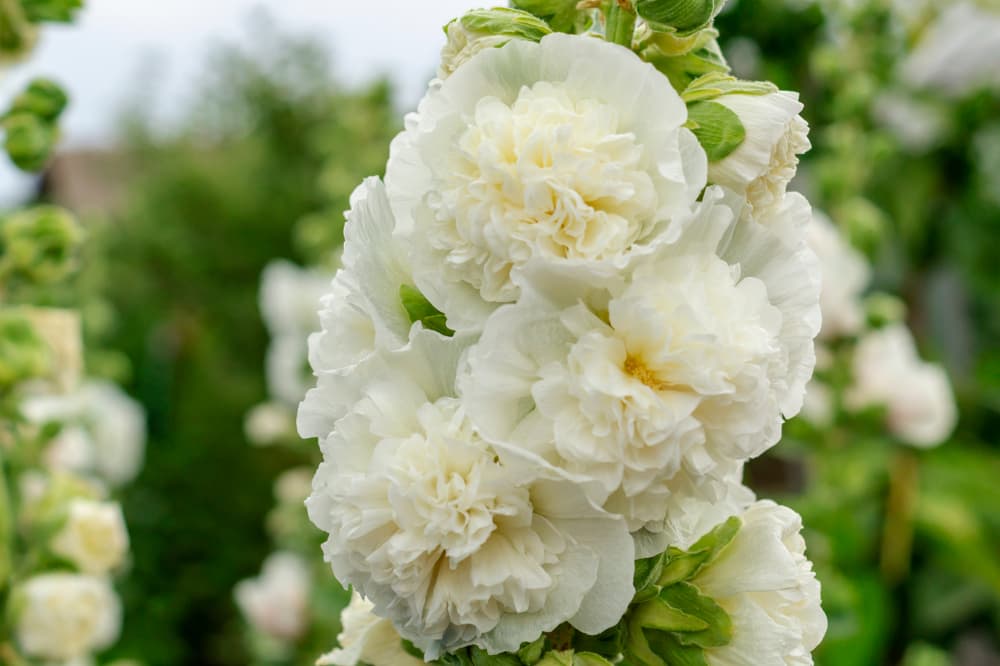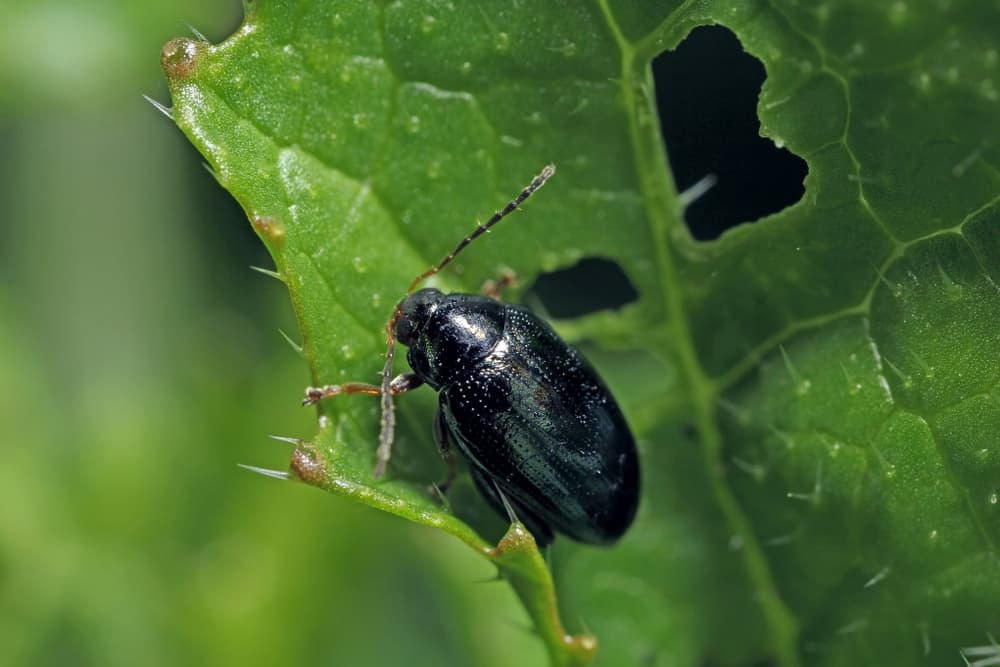Gardeners’ Hollyhock Growing Advice For That Quintessential Cottage Garden Look

BIENNIALS > HOLLYHOCKS

Ed is a horticultural therapist, professional gardener and writer. Ed has a BSc in Occupational Therapy from Coventry University and a Diploma in Social and Therapeutic Horticulture (DipSTH) via Thive, the RHS and Pershore College. Ed runs a community kitchen garden in West Sussex, where he leads horticultural therapy sessions.
Reviewed By ROY NICOL

Roy is a Professional Gardener and Horticultural Consultant, specialising in large garden year-round maintenance and garden development. He is an RHS Master of Horticulture and uses his research in the application of no-dig methods in ornamental garden settings. Roy has been a Professional Gardener for more than six years and is a member of the Chartered Institute of Horticulture, Professional Gardener's Guild and Association of Professional Landscapers (Professional Gardener).
IN THIS GUIDE
HOLLYHOCK GUIDES
Hollyhocks are perhaps one of the quintessential cottage garden plants there are.
Botanically named Alcea rosea, they provide tall towers of jewel-like flowers during the summer months.
Hollyhocks are easy to grow and care for and look impressive in any border or planting scheme.
Hollyhocks are often thought of as perennial plants, as they tend to come back year after year.
Although they live on and flower for only a few years, they self-seed readily into any available crevice and therefore will spread around if allowed.
Overview
| Botanical Name | Alcea rosea |
| Common Name(s) | Hollyhocks |
| Plant Type | Biennial |
| Native Area | Eurasia |
| Hardiness Rating | H5 |
| Foliage | Large spires / deciduous |
| Flowers | Various colours |
| Flowering Months | June, July, August, September |
Sunlight
Preferred
Full Sun
Exposure
Exposed or Sheltered
Size
Height
1.5 – 2.5M
Spread
0.5 – 1M
Bloom Time
June – September
Soil
Preferred
All soil types
Moisture
Well-drained
pH
Any
They are, however, actually a biennial – meaning that they flower the year after being sown.
It is thought that they originated from Asia and were introduced to the UK in the 15th century and are classified as part of the Malvaceae or mallow family, along with Lavatera, abutilon and hibiscus.1Berry, P. (1998, July 20). Malvaceae | plant family. Encyclopedia Britannica. Retrieved March 17, 2023, from https://www.britannica.com/plant/Malvaceae
Hollyhocks are a tall slender plant, perfect for the back of a border, as some can grow in excess of 2m given the right conditions.
Large flowers decorate their tall stems in all manner of colours, from pink and yellow right through to purple and even almost black.

Listed as one of the Royal Horticultural Society’s plants for pollinators, they provide a great source of nectar and pollen for bees and other insects when they are in flower, during the summer months.2RHS Plants for Pollinators. (n.d.). Royal Horticultural Society. Retrieved March 17, 2023, from https://www.rhs.org.uk/science/pdf/conservation-and-biodiversity/wildlife/plants-for-pollinators-garden-plants.pdf
Common Varieties
There are many different hollyhock varieties available here in the UK, so it is simply a choice of which colours would go well with a chosen colour scheme or planting plan.
Available as either single or rather elaborate double flowers, all are equally impressive to grow, however, most double versions are not pollinator-friendly.
To help you choose here are five of the best varieties available here in the UK:
A. ‘Sunshine’

Single large yellow flowers: 1.8m x 0.5m.
A. ‘Blacknight’

Single dark purple, almost black flowers: 2m x 0.5m
A. ‘Halo Apricot’

Single dusky pink flowers with a contrasting purple center: 1.8m x 0.5m
A. ‘The Bride’

Double white flowers with a ruffled appearance: 2m x 0.6m.
A. ‘Chaters Double Rose’

Double bright pink flowers with a ruffled appearance: 1.8m x 0.6m
Hollyhocks can suffer from rust, which is best avoided if possible.
Some varieties are now bred to be more rust-resistant which is something to keep in mind when choosing.
How To Grow Hollyhocks
Hollyhocks are real sun lovers.
They prefer a south or west-facing spot in the garden and are more suited to beds and borders rather than containers.
Although happy in either a sheltered or exposed situation, try and avoid a really exposed site, as they will catch the wind due to their height.

Hollyhocks can cope will most soils if well-drained and relatively fertile, but they may struggle if grown on clay.
Saving Seeds
Hollyhocks are a relatively easy plant to grow from seed, whether bought or saved from previous plants, but beware that any plants grown from parent plants may not necessarily come true.
To save the seed from a plant, it is necessary to leave the flower stems on until after they have finished flowering.
Wait until the seed heads turn brown, remove the pods and keep in a dry and moisture-free container until sowing.
“Paper envelopes are best for this and sealed plastic containers should be avoided as the seed can spoil,” says Master Horticulturist Roy Nicol.

“They should be kept completely dry and cool until they are ready to sow.”
Hollyhock seeds are large, flat and easy to handle and are hence a great flower to sow with children.
The seeds are best sown under cover, such as in a greenhouse or on a windowsill in April or May, or directly into the ground in June, once the soil has warmed up.
See our guide to sowing Hollyhocks for a full breakdown of the entire process.
Planting Out
To plant out a hollyhock in a pot, prepare the ground first by removing any weeds and incorporating some organic matter or compost.
Plant the hollyhock in the ground at the same depth it was in the pot, firm in and water well.

Hollyhocks need lots of space so the recommended spacing if planting in groups is 60cm apart.
Hollyhock Plant Care
Hollyhocks are an easy plant to grow and look after as they require little maintenance.
Readily available as plants from garden centres or online, they can also be bought as plug plants and seeds.
Staking

In an exposed garden, it is advisable to tie the stems as they grow to a stake or bamboo cane to save them from getting blown over.
Feeding & Watering
Hollyhocks need regular watering to begin with, but once established the plants should not need much except during hot and dry spells.
Hollyhocks shouldn’t need to be fed during the growing season, especially if the soil is relatively fertile already.
If the soil is already poor to begin with, it is worth adding some well-rotted organic matter prior to planting or applying fertiliser during the growing season as a liquid feed.
Once the flowers have died back, the stems can be left on to allow the seed pods to naturally self-seed around, the seed saved and stored for future sowing, or cut down.

Companion Planting
Hollyhocks have long been regarded as a stalwart of cottage garden planting and look equally good in a coastal garden scheme or planted along a wall.
Hollyhocks go well with many typical cottage garden plants including – but not limited to – delphiniums, peonies, phlox, lavender and lupins.
“The range of colours lupins have can be used to great effect with hollyhocks to set up complimentary colour schemes, along with other stalwarts of the cottage garden, such as roses and foxgloves,” says Roy.
Common Problems
Slugs
Young hollyhock plants are especially attractive to slugs.
When plants are small, try surrounding them with barriers, such as wool pellets or copper rings and try and encourage predators including birds, frogs and hedgehogs into the garden.
“Treating the soil hollyhocks are planted in with nematodes can also be an effective organic approach,” Roy adds.
Homemade slug traps and torchlight searches can prove surprisingly effective as well.
Flea Beetle
Along with brassicas, hollyhocks are susceptible to damage from the flea beetle.

Damaging the leaves and sometimes the roots, the flea beetle’s calling card is round holes in hollyhocks foliage.
The holes can only be a few and nothing to worry about, but a bad infestation can leave the foliage looking like a Swiss Cheese, with more holes than leaf.
Control can include picking the beetles off and encouraging more predatory birds, frogs and hedgehogs into the garden.
However, with a bad infestation, contact insecticides may have to be applied – but not when the plant is in flower – as this poses a danger to bees and other pollinators.
For example, although pyrethrins are an organic contact pesticide, they are toxic to honey bees.
References
- 1Berry, P. (1998, July 20). Malvaceae | plant family. Encyclopedia Britannica. Retrieved March 17, 2023, from https://www.britannica.com/plant/Malvaceae
- 2RHS Plants for Pollinators. (n.d.). Royal Horticultural Society. Retrieved March 17, 2023, from https://www.rhs.org.uk/science/pdf/conservation-and-biodiversity/wildlife/plants-for-pollinators-garden-plants.pdf
